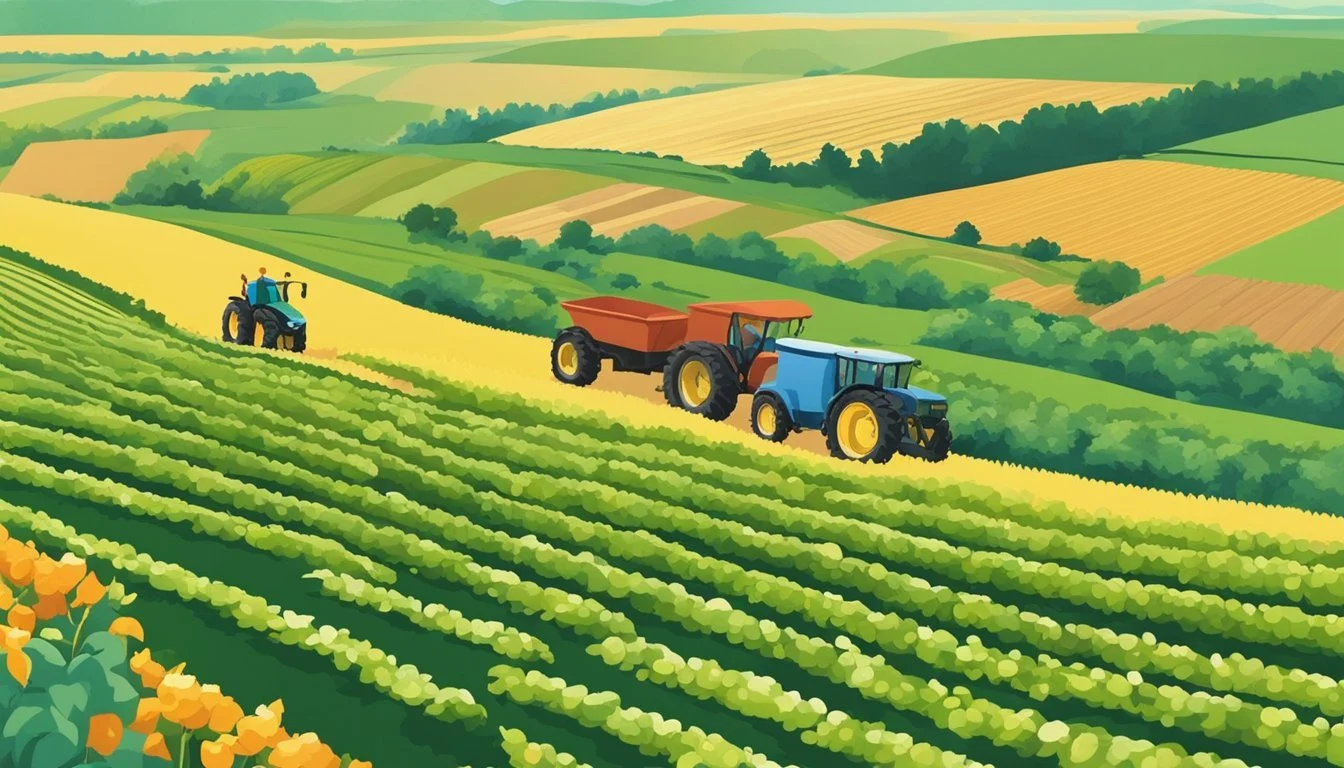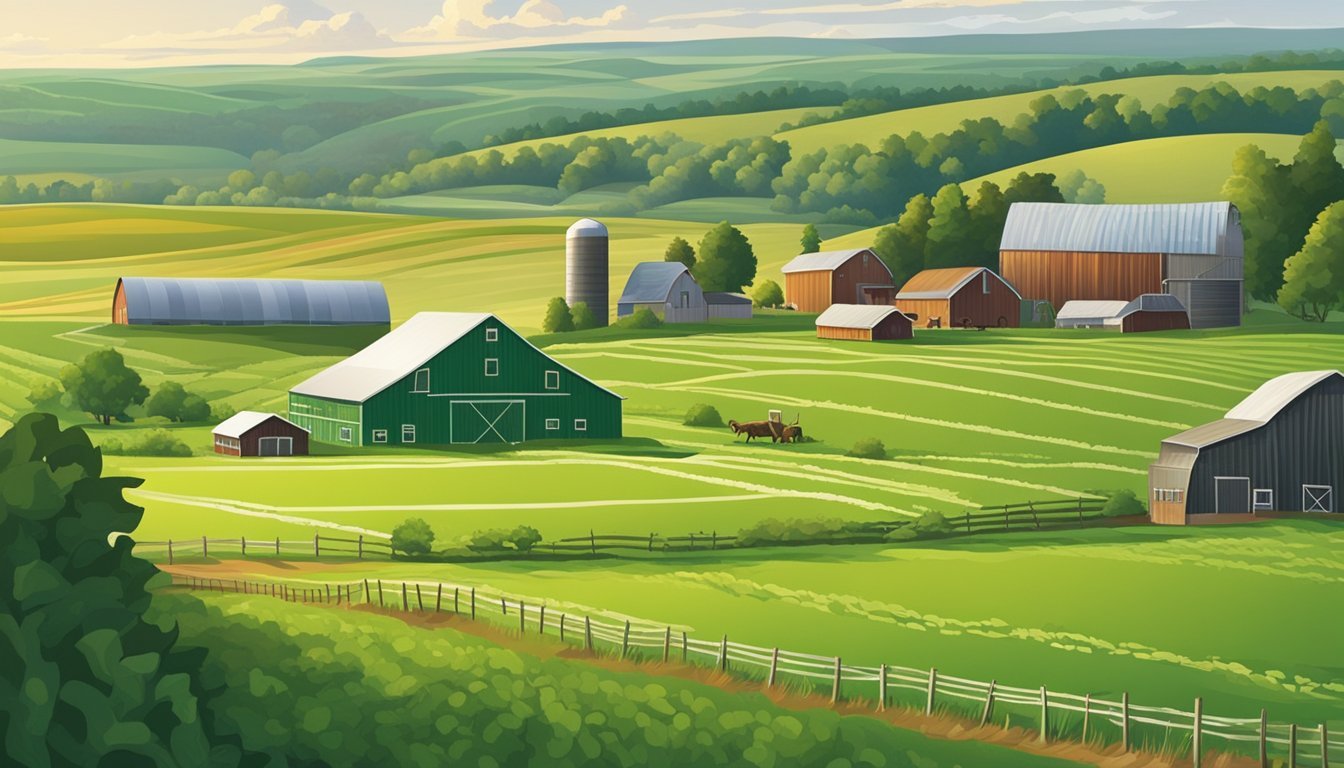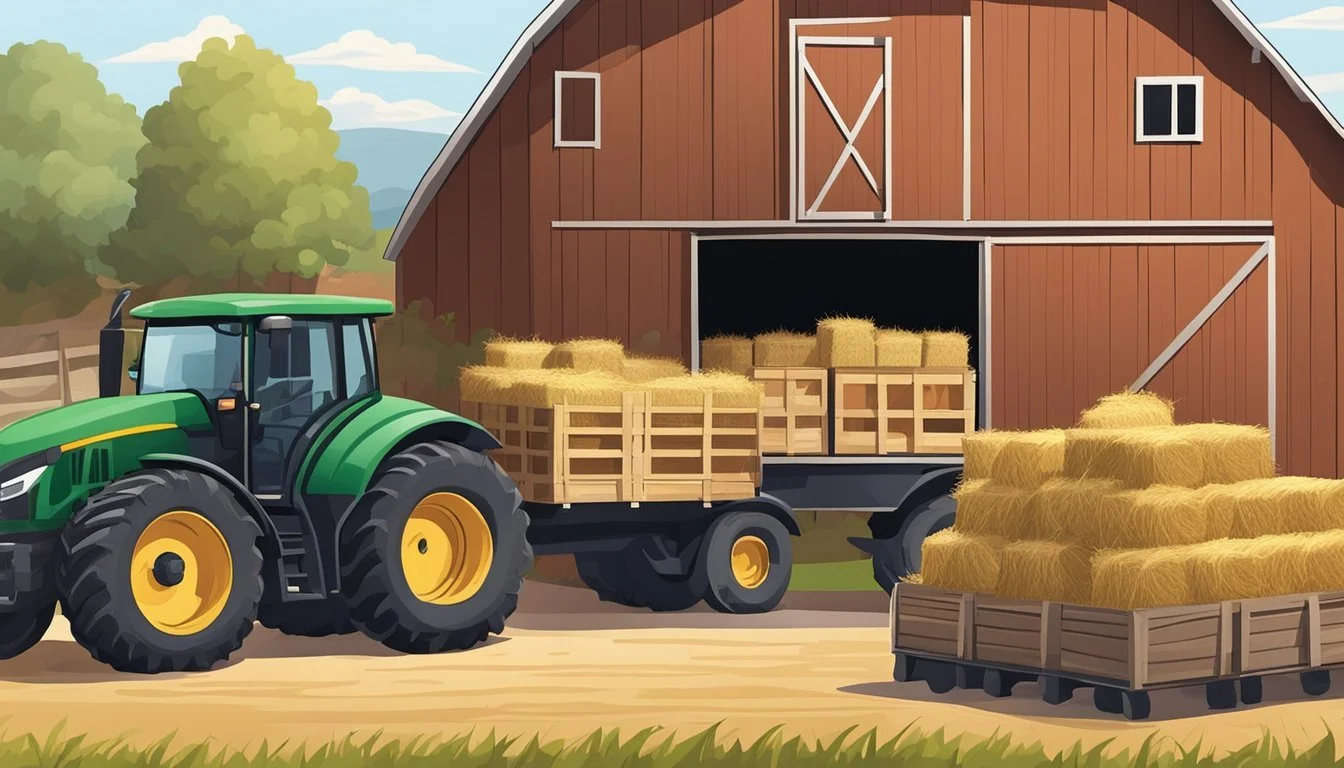Guide to Farming in Minnesota
Essential Tips for Prosperous Cultivation
This Article is Part of Our State by State Farming Guide
Farming in Minnesota is a cornerstone of the state's economy and cultural heritage. Known for its diverse agricultural output, the state produces a variety of crops and livestock that not only feed the local population but also contribute significantly to the national and global markets. With its rich soil, ample water resources, and a climate conducive to a wide range of farming activities, Minnesota farmers are well-equipped to handle the challenges and opportunities of agricultural production.
Agriculture in Minnesota is a dynamic and evolving sector that benefits from both traditional practices and modern innovations. The state's farmers are known for their resilience and adaptability, which are essential in responding to changing weather patterns and market demands. Resources such as the 2023 Farm Resource Guide, compiled by UMN Extension, offer valuable information on farm business management, underscoring the state's commitment to supporting its agricultural community.
Minnesota's Department of Agriculture plays a pivotal role in fostering a sustainable farming environment. The department provides support and guidance through various services and regulations, ensuring that agricultural practices not only yield productive outcomes but also adhere to environmental and safety standards. This balance between productivity and sustainability is at the heart of Minnesota's agricultural ethos, positioning the state as a leader in the farming industry.
Understanding Minnesota's Agricultural Landscape
Minnesota's diverse climate and soil conditions provide a fertile ground for a variety of crops and livestock. In this section, we'll examine the specific climate and soil aspects that influence agriculture in Minnesota, as well as the primary crops and livestock that comprise the state's farming industry.
Climate and Soil Conditions
Minnesota’s climate ranges from hot summers to cold winters, a characteristic of its continental climate. Soil types vary significantly across the state, with fertile soil known as the black earth or "chernozem" found in the Red River Valley, contributing to its agricultural productivity. This variability in climate and soil affects both what can be grown and how it is managed.
Temperature: Summers are warm, providing good growing conditions, while winters require hardy crop and livestock breeds.
Soil: Varied across regions, from the nutrient-rich prairie soils to peatlands in the north.
Key Crops and Livestock
Crops
Minnesota's agricultural output is diverse, with corn and soybeans (how long do soybeans last?) as the main cash crops. Other significant crops include:
Wheat and oats: Grains that thrive in Minnesota’s soil and climate.
Sugar beets: A significant crop for the state, making Minnesota a leading producer.
Peas, snap: Grown as vegetables; part of state's varied crop production.
A tabular representation of key crops:
Crop Description Corn Predominant grain crop, used for feed and ethanol Soybeans Second most common crop, used for oil and feed Wheat Grown primarily in the northwestern part of the state Sugar Beets Critical to the state's sugar production industry
Livestock
Livestock farming also contributes greatly to Minnesota's agricultural landscape with:
Milk: Dairy farming generates significant revenue.
Hogs: Pork production is a major part of the livestock sector.
Beef: Cattle farming is practiced, albeit on a smaller scale than hog farming.
Turkeys: Minnesota is a major turkey producing state.
Livestock data in brief:
Dairy Farms: Produce large quantities of milk; contributes to the state’s agricultural economy.
Hog Operations: Intensive pig farming to meet high demand for pork.
Beef Cattle: Raised in both feedlots and grass-fed systems.
Turkey Production: A specialized sector with significant output for both domestic consumption and export.
Agricultural Practices in Minnesota
In Minnesota, farming practices prioritize sustainable growth and the adoption of innovative technologies. These efforts aim at enhancing agricultural efficiency, soil health, and environmental stewardship.
Sustainable Farming Methods
Minnesota farmers employ various sustainable farming methods to ensure long-term agricultural productivity and environmental health. One of the key conservation practices includes the use of cover crops, which play a crucial role in improving soil structure, preventing erosion, and enhancing water retention. They help in maintaining soil health by adding organic matter and fixing nitrogen in the soil.
Pest and weed management in Minnesota are tackled with an integrated approach, combining mechanical, biological, and chemical strategies to manage pests and weeds effectively without undue harm to the environment. Green practices are encouraged, promoting ecological balance and reducing reliance on chemical pesticides.
Technology and Innovation in Agriculture
Advancements in technology and innovation are at the forefront of modern-day agriculture in Minnesota. Farmers deploy precision agriculture tools like GPS-guided equipment to optimize planting, harvesting, and resource management, leading to increased efficiency and reduced waste.
Farm machinery has evolved to be more efficient and less harmful to the environment, with many machines now designed specifically to limit soil compaction and to be used in tandem with conservation tillage practices. This careful approach to technology adoption ensures the sustainability and profitability of Minnesota's agricultural sector.
Planting and Harvesting Schedules
In Minnesota, farmers strategically plan planting and harvesting schedules to align with the state's distinct seasons. Timing is crucial to ensure a successful yield for both annual and perennial crops.
Seasonal Farming Activities
Spring: Farmers typically begin planting as soon as the threat of frost has passed. On average, the last frost date occurs around mid to late April, but this can vary depending on the specific region in Minnesota. Common crops like tomatoes and peppers should be planted after this last frost date to ensure optimal growth.
Planting Dates for Common Annual Vegetables:
Tomatoes: May 15 - June 1
Peppers: May 15 - June 1
Lettuce: April 15 - May 10
Summer: This is the peak season for growth and maintenance of crops. Farmers must stay vigilant for pests, weeds, and drought conditions that can negatively affect the plants.
Fall: Harvest times for most crops will fall between late August and early October. It’s important to keep track of the first frost dates to safeguard sensitive crops:
Expected Harvest Dates for Common Annual Vegetables:
Tomatoes: August 20 - September 30
Peppers: August 20 - October 10
Lettuce: June 1 - October 15
Winter: Some hardy crops can withstand the cold and be harvested during this season, while others need to be harvested before the first frost.
First frost date: Typically around October 10th
Crop Rotation and Diversification
Farmers employ crop rotation to maintain soil health and reduce pest and disease pressure. A three to four-year rotation schedule is common, with a good mix of crops from different families.
Example Rotation Schedule (Yearly):
Year 1: Legumes (beans, peas)
Year 2: Solanaceae (tomatoes, peppers)
Year 3: Brassicas (cabbage, kale)
Year 4: Root vegetables (carrots, beets)
Diversification is also a key strategy to ensure stable farm productivity across different environmental conditions. A combination of staple crops with varying maturity dates allows for a continuous harvest season and mitigates the risk of total crop failure due to pests, diseases, or adverse weather.
Water Management and Soil Conservation
Effective water management and soil conservation are critical pillars for sustainable farming practices in Minnesota. These efforts ensure the longevity of agriculture and safeguard natural resources.
Irrigation Techniques
Minnesota's agriculture relies heavily on irrigation to maintain crop health. Approximately 95 billion gallons of water were used for this purpose in 2017. For optimized water use, farmers employ various irrigation techniques tailored to their land's specific needs. They include:
Drip irrigation: Delivers water directly to the plant roots, reducing evaporation losses.
Center pivot: Allows for efficient watering of large fields with minimal labor.
Farmers must balance irrigation with water quality conservation, adopting practices that prevent runoff and protect local waterways.
Land Preservation
The conservation of soil and water in Minnesota encompasses a comprehensive approach which combines:
Conservation Planning: Collaboration between farmers and the Natural Resources Conservation Service (NRCS) provides guidance on implementing effective conservation strategies.
Soil Conservation Practices: Techniques such as crop rotation, cover cropping, and reduced tillage help maintain soil fertility and structure, preventing erosion and degradation.
Landowners work with the Minnesota Board of Water & Soil Resources (BWSR) and private organizations to achieve these goals, with benefits that extend beyond their individual properties to the state's ecological health as a whole.
Livestock and Dairy Management
Minnesota's approach to livestock and dairy management emphasizes a synergy of advanced husbandry practices and efficient processing methods. The state's farms are known for high-quality milk and meat products, achieved through effective animal care and modern processing facilities.
Animal Husbandry
Prudent livestock care is foundational to farm productivity in Minnesota. Farmers prioritize basic husbandry practices such as ensuring animals have access to clean water and are kept in dry, low-stress environments. Proper nutrition is a key focus, with livestock feed often including components like silage, which provides essential nutrients. For dairy cattle, this translates into not only better health but also to higher milk yields.
In addition to physical well-being, clear communication is crucial among farm workers to maintain consistent animal care standards. Preparation for variable weather conditions and adaptation to new farming technologies are also integral to successful livestock management.
Milk and Meat Processing
Once milk is collected from dairy cows, it undergoes processing which is an intricate and regulated process. Permitted dairy farms sell milk to processing facilities that ensure it is safely pasteurized and prepared in a variety of products such as cheese, butter, and ice cream. For meat processing, facilities adhere to strict sanitary guidelines to produce safe and high-quality meat products, often derived from animal sources such as cows and hogs.
Quality control is essential in every step of the processing phase to maintain the state's reputation for safe, quality milk and meat. Minnesota's processing plants not only serve the local demand but also contribute to national and international markets, adhering to meticulous standards throughout the supply chain.
Farm Economics and Marketing
Minnesota's farm economy thrives not only on abundant cropland but also on strategic marketing and financial planning. Effective management in these areas ensures the state's position as a leader in agricultural production.
Market Trends
Minnesota's agricultural market boasts significant contributions to the state economy, with agriculture and its related industries employing one out of every five workers. The state ranks 6th nationwide in agricultural sales, generating substantial economic activity. Market trends show a diversified portfolio in crops and yields, ensuring resilience against market volatility. Current data highlights the importance of staying informed on:
Commodity prices: Regular monitoring can impact planting decisions and marketing strategies.
Rental rates: Fluctuations in land rental rates affect profit margins for farmers leasing additional cropland.
Recent cost trends: Keeping abreast of input costs helps farmers manage their production expenses efficiently.
Financial Strategies for Farmers
Financial planning is critical for sustained success in farming. Minnesota farmers have access to a variety of resources to manage their financial needs:
Financial assistance: Programs available through state and federal sources can help with both short-term liquidity and long-term investments.
Contract negotiation: Understanding and negotiating contracts, particularly leases, can ensure fair terms and protect farmers' interests.
Farmers frequently utilize tools such as the Farm Resource Guide to stay updated on financial strategies, which includes essential information on:
County-based yields
Lease agreement forms
Investing time in financial education and strategic market analysis positions Minnesota farmers for continued economic success within the rigorous demands of agriculture.
Government Support and Regulations
In Minnesota, both federal and state-level programs and regulations offer crucial support to the farming industry, ensuring that agricultural practices align with environmental and economic standards.
USDA Programs
The United States Department of Agriculture (USDA) extends various programs to Minnesota farmers, with emphasis on sustainability, conservation, and land management. Natural Resources Conservation Service (NRCS) is pivotal in providing technical and financial support through initiatives like the Environmental Quality Incentives Program (EQIP). These programs assist producers in implementing conservation practices that benefit the environment and preserve natural resources.
Conservation Programs:
EQIP: Offers financial and technical help for conservation improvements.
Conservation Stewardship Program (CSP): Rewards agricultural practices that promote soil and water health.
Support for Forest Landowners:
USDA provides assistance for sustainable management and conservation of forest lands.
State-Specific Guidelines and Assistance
Minnesota has tailored programs to meet the unique needs of its farming community. State-specific guidelines aid in preserving agricultural land, while various assistance programs are available for both urban and traditional agricultural endeavors. The Minnesota Department of Agriculture (MDA) supports the state's agricultural heritage through several channels:
Preservation Programs:
Minnesota Agricultural Land Preservation Program: Encourages the maintenance of agricultural land use outside the Twin Cities metro area.
Urban Agriculture:
MDA empowers urban youth agricultural education and community development in urban agriculture.
Guidelines for Conservation Planning:
The state offers resources for farmers to connect with conservation planners to optimize land use while adhering to environmental regulations.
By leveraging these federal and state resources, Minnesota’s agricultural sector can thrive in a regulated, supportive environment that balances productivity with sustainability.
Community and Education
In Minnesota, community involvement and educational opportunities play a crucial role in supporting farmers. They provide access to the latest agricultural news, events, and comprehensive educational resources designed to enhance farming practices and business management.
Agricultural Events and News
Farmers in Minnesota have access to a variety of events and publications that help keep them informed about the latest developments in the agriculture sector. Events such as county fairs and university extension programs offer venues for farmers to learn, network, and share insights. They can stay up-to-date with agricultural news through various channels, including:
University of Minnesota Extension's news releases
Newsletters from agricultural organizations
Local community bulletins
Educational Resources for Farmers
The state of Minnesota places a strong emphasis on education for its agricultural community. The University of Minnesota Extension, for example, provides a wealth of educational resources that include:
Farm Business Management Information: Tools and publications to guide farmers in effective business planning.
Curriculum: Educational materials that connect classroom learning with agricultural practices.
Video Resources: Documentaries and videos produced by authoritative sources like the University of Minnesota Extension help illustrate the impact of farm to school programs, delivering information in an engaging format.
These resources aim to empower local farmers by promoting informed decisions, sustainable practices, and continuous growth within the industry.
Storage and Transportation
Efficient storage solutions and transportation logistics are fundamental for the productivity and profitability of farming in Minnesota. Maintaining grain quality and adhering to state and federal transportation regulations is crucial.
Grain Storage Solutions
Grain Quality Maintenance:
Temperature Control: Maintaining a consistent temperature in grain silos prevents spoilage.
Moisture Management: Grain should be stored at appropriate moisture levels to avert mold growth.
Storage Facility Options:
On-Farm Silos: For immediate, short-term storage and easy access.
Commercial Elevators: For long-term storage with advanced maintenance capabilities.
Transport Logistics
Local Regulations:
First Haul Rule: The initial haul of unprocessed farm products is permissible within 100 miles of production.
Transportation Partnerships:
Minnesota Farm Bureau Foundation: Collaborates with entities such as the Minnesota Soybean Research and Promotion Council and Compeer Financial to provide resources on transport regulations.
Handbook Utilization:
Agriculture Transportation Handbook: Offers guidelines on state and federal statutes, rules, and exemptions pertinent to agricultural transportation.
Minnesota Farming Challenges and Opportunities
Minnesota's agricultural sector faces several challenges related to climate change and market dynamics, yet these also present opportunities for innovation and growth in the farming community.
Adapting to Climate Change
Minnesota farmers must navigate the complexities of changing weather patterns, including increased frequency of extreme weather events and variability in precipitation. This requires a strategic approach to resource management and crop selection to ensure resilience. Farmers are exploring drought-resistant crops and investing in water-efficient irrigation systems to mitigate these risks.
Exploring New Markets
Navigating global trade tensions and fluctuating commodity prices has encouraged Minnesota farmers to explore new markets. Diversifying products and seeking out niche markets offer opportunities for increased profitability. The growing interest in locally sourced and organic foods opens up avenues for small farm owners. To capitalize on these trends, farmers are leveraging direct-to-consumer sales channels and exploring value-added processing.
Conclusion
The farming landscape in Minnesota is as varied as it is dynamic, catering to small hobby farms, specialty producers, and large-scale operations. University of Minnesota Extension plays a pivotal role in disseminating critical, science-based knowledge ensuring that Minnesota's agricultural community thrives in efficiency and innovation.
Key resources such as the 2023 Farm Resource Guide equip farmers with practical education vital for navigating the complexities of modern agriculture. The focus on economic sustainability is evident in analyses like the Economic Contribution Study of Minnesota Agriculture, which reveals the nuanced influence of farming on the local economy, emphasizing the importance of agriculture to Greater Minnesota despite its proportionally small impact on the state's overall financial picture.
The commitment to environmental stewardship is further highlighted through the incorporation of practices such as cover cropping, offering ecological benefits without compromising farm profitability. Farmers harness these techniques, representative of the state’s average agricultural practices, to enhance soil health and long-term sustainability.
In conclusion, the collective effort of Minnesota's farmers, backed by robust research and support systems like UMN Extension, ensures that the state remains at the forefront of agricultural excellence and resilience. This partnership fosters a community ready to meet contemporary challenges and to sustainably feed a growing population.








